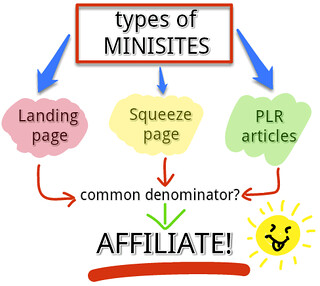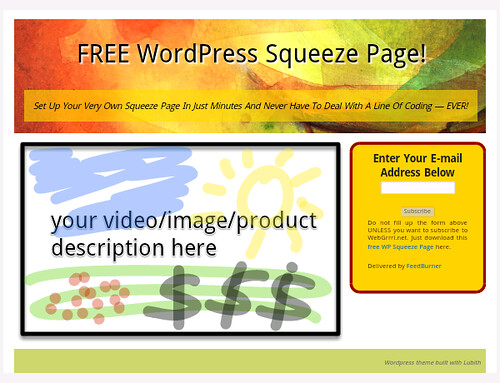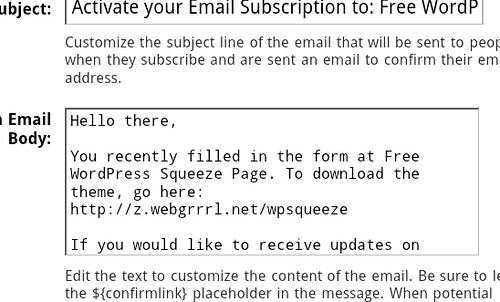NOTE: This post is outdated, and many of the links and demo have been removed. Check out my newer post on WordPress as a minisite for updates. Old post follows.
A commenter in one of my posts mentioned about building minisites using WordPress, which got me interested to do a research about what exactly defines a minisite.
It appears that a minisite can be a lot of things to a lot of people, but particularly meaningful to affiliate marketers. Let me summarize what I know about minisites in one ugly diagram.

With this simple understanding, I’m covering my WordPress minisite post in three parts, starting with WordPress as a squeeze page. As with any website you want to create, it is wise to first plan what functions and content you want to have on your website in order to achieve your objective. WordPress will handle most of the issues that have to do with usability as well as ease of setup and maintenance.
The anatomy of an affiliate squeeze page
A squeeze page is basically a short version of a sales pitch and should preferably fit within your monitor screen without having to scroll down the site for more details, as compared to a landing page which is longer and has more info.
At the very least, to use WordPress as a squeeze page, you will need:-
- A downloadable product, such as an e-book, an app, or whatever file that is commonly downloadable through the Internet.
- A mailing list manager to collect your visitor e-mails after they fill in the form to download your product.
- Your catchy product sales pitch, which would probably be a combination of a description, audio, image, video and a convincing call-to-action phrase.
- A WordPress squeeze page theme.
Seriously, that’s all there is to it. Of course, you can go the extra mile and install other sophisticated plugins for your WordPress squeeze page if you want to. It really depends on how much you want your squeeze page to do. However, if the only thing you’re trying to achieve is build your mailing list and allow your users to download a freebie, then you’ll need no more than those four things mentioned.
Laying out your squeeze page with WordPress
 Scan this code to access the Free WordPress Squeeze Page demo (LINK NO LONGER WORKS)
Scan this code to access the Free WordPress Squeeze Page demo (LINK NO LONGER WORKS)
For experimenting purposes, I built a working demo of a squeeze page using WordPress* (link removed) in a totally BUM marketing way. There are countless ways to tackle this project, and this is just one of the quickest way to do so (IMHO, of course).
At first, I wanted to run using those ready-made WordPress themes for squeeze pages strewn across the Web , but I soon found that ALL of the themes has those sneaky base-64 code written in them . So instead of inflicting damage on your site with those pretty but nasty themes, I took the liberty to create a simple squeeze page theme just for this post.

Albeit the fugly graphics, it’s clear that the theme has the looks of a standard squeeze page. You have your headings there, with a short tagline that hopefully pulls people into learning more about your product. Then, you have a teaser video which would probably convince them to sign up via the in-your-face opt-in form.
Building your WordPress squeeze page for free
Every element of my demo squeeze page (sans my cheap hosting) are DIY and doesn’t cost me a cent.
WordPress Squeeze Page Theme: My theme was created using the free WordPress theme generator, Lubith (aff), and is based on the built-in Twenty Twelve theme. Remove all unneccessary parts of a blog template, such as post meta, comments, multi-post option and so forth, and you have your standard squeeze page template. Since the theme is based on Twenty Twelve, it inherits all editor capabilities of customizing the header, background and color of your site without dabbling with the stylesheets. Remember to set the number of posts displayed to 1 in your Settings.
Downloadable Product: I made this theme as my product. Easy. Just replace this with yours.
Catchy Product Sales Pitch: I’m not much of a marketer, so I just put up some random stuff up there, including a WordPress.tv video about using WP for free. If you’re using Private Label Rebrandable (PLR) products, just stuff the product cover onto a fresh post, include your fancy audio, video / bullet points, and publish it so it will appear in the page.

Mailing List Manager: I’ve opted to use something free and quick to set up. This means that this is no fancy Aweber service you’re looking at. Instead, you’ll be amazed at how flexible FeedBurner can be when you get creative. For the demo, I customized the confirmation e-mail that a user receives after the opt-in form is submitted, by including the download URL to my theme. I don’t really want anyone to subscribe to my list, since this is just a demo. Take note, though, that the emails are collected and stored for you by FeedBurner, regardless whether or not the users confirm their subscription.
Final note on squeeze pages using WordPress
The mailing list manager should be one of the aspects you should consider in much detail, and many WordPress plugins can help you go the extra mile with your page. I’ll be sure to get back and update this post with plugin reviews later after the blogging challenge is complete. As with the theme, the free WP plugins that claim to simplify your squeeze page can also contain base-64 codes. It’s best to stick to the plugins found at WP.org which are scanned and verified safe.
Check out my other posts: « Blog Aggregator: how to create one with WordPress, part 4 / Awesome-est text troll stories »